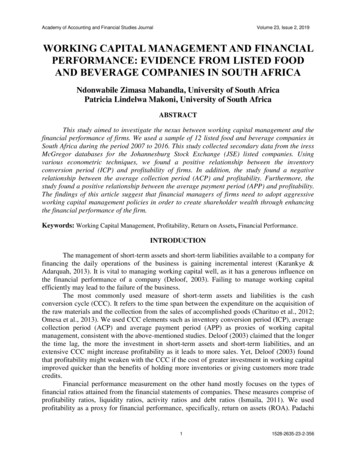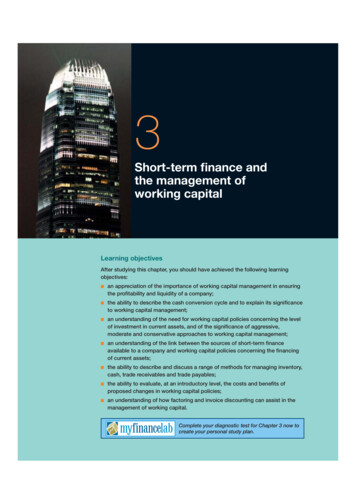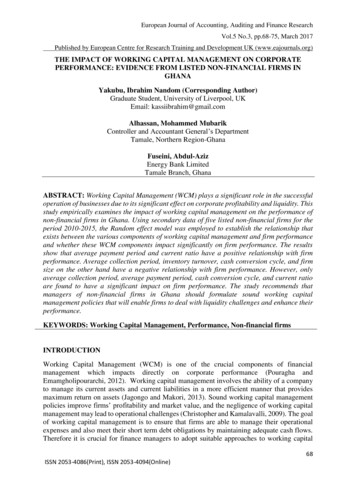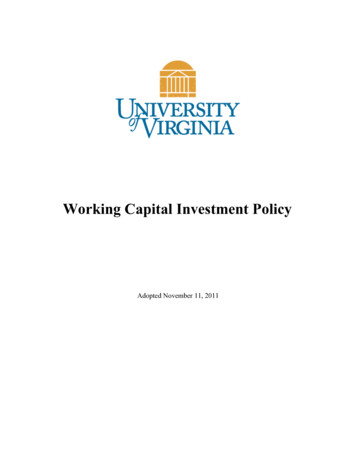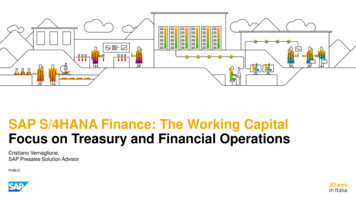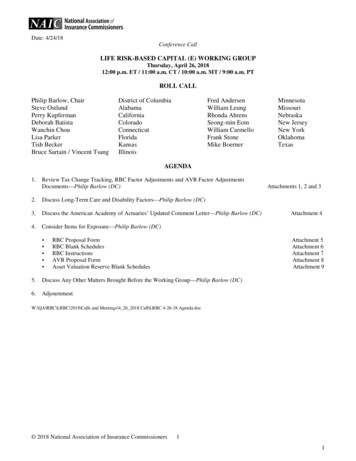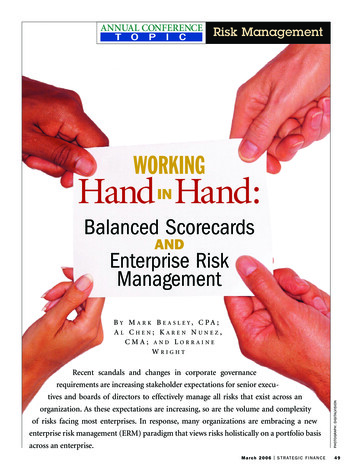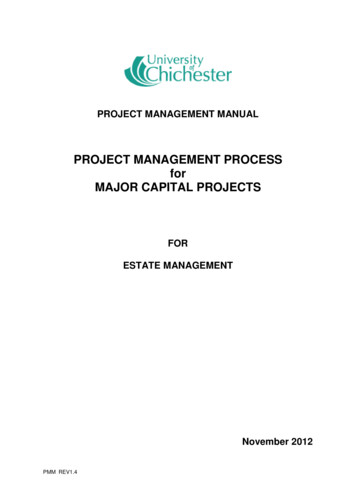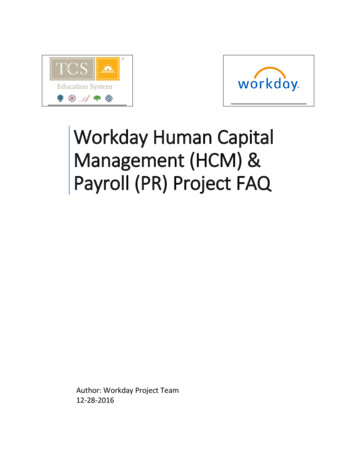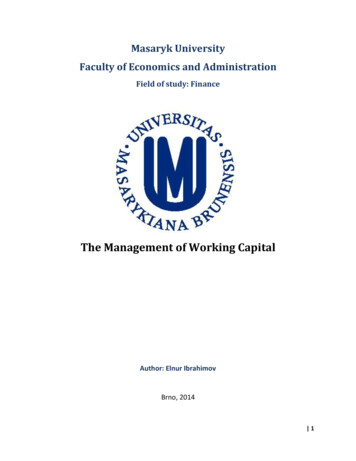
Transcription
Masaryk UniversityFaculty of Economics and AdministrationField of study: FinanceThe Management of Working CapitalAuthor: Elnur IbrahimovBrno, 2014 1
THE MANAGEMENT OF WORKING CAPITALTABLE OF CONTENTINTRODUCTION . . 3OBJECTIVE OF WORKING CAPITAL MANAGEMENT 3CONCEPTs AND DEFINITION OF WORKING CAPITAL .3TYPES OF WORKING CAPITAL MANAGEMENT 4THE POLICY OF WORKING CAPITAL MANAGEMENT . 5CONCLUSION . 8REFERENCES 9 2
INTRODUCTIONGenerally, working capital typically means the firm’s current or short-term assets such ascash, receivables, inventory and marketable securities. These items are also referred to ascirculating* capital.Working capital management is concerned with the problems that arise in attempting tomanage the current assets, the current liabilities and the interrelations that exist betweenthem. As we knew, current assets refer to those assets which in the ordinary course ofbusiness can be, or will be, converted into cash within one year without undergoing adiminution in value and without disrupting the operations of the firm. For instance, cash,marketable securities, accounts receivable and inventory. By the way, current liabilities arethose liabilities that are intended, at their inception, to be paid in the ordinary course ofbusiness, within a year, out of the current assets or the earnings of the concern. Forexample, it is possible to be mentioned accounts payable, bills payable, bank overdraft andoutstanding expenses.OBJECTIVE OF WORKING CAPITAL MANAGEMENTAs already mentioned above, basically, the main purpose of working capital managementis to manage the firm’s current assets and liabilities in such a way that a satisfactory level ofworking capital is maintained. From this point of view, it can be clearly seen that theinteraction between current assets and current liabilities is, therefore the main theme ofthe theory of the working capital management.CONCEPTS OF WORKING CAPITALAccording to the real process of working capital, we can say working capital is the capitalyou require for the working for example, functioning of your business in the short run.There are two possible interpretations of working capital concept: Gross working capital- refers to the firm’s investment in the current assets andincludes cash, short term securities, debtors, bills receivables and inventories.It is necessary to concentrate on the fact that the investment in the current assetsshould be neither excessive nor inadequate. Net working capital- generally refers to the difference between the current assetsand the current liabilities.* Circulation capital means assets of a company that are changed in the ordinary course of business from oneform to another, as for example, from cash to inventories to receivable, receivable to cash. 3
Current liabilities are those claims of outsiders, which are expected to mature for thepayment within an accounting year include creditors, bills payable, bank overdraft andoutstanding expenses.When current assets exceed current liabilities it is called positive working capital andwhen current liabilities exceed current assets it is called negative working capital.TYPES OF WORKING CAPITAL MANAGEMENTCommonly, there are two types of working capital are needed in the business:1. Permanent Working Capital2. Variable Working CapitalThese two types of working capital can also be classified as under:Working CapitalPermanent Working CapitalVariable Working t working capital: This is the minimum level of current assets, which iscontinuously required by the firm to carry on its business operations. It is permanent in thesame way as the firm’s fixed assets are. Depending upon the changes in the production andsales, the need for working capital, over and above the permanent working capital, willfluctuate. 4
Variable working capital: This is the working capital which, keeps on changing with thechange in the production and sales activities. It is the extra working capital, over the abovethe permanent working capital, that is needed to support the changing production andsales activities. This type of working capital is also called as fluctuating or variable workingcapital.The difference between the permanent and variable working capital may be represented inthe following two diagrams:Amount ofWorking CapitalVariable working capitalPermanent working capitalTimeAmount ofWorking CapitalVariable working capitalPermanent working capitalTimeDifference between permanent and variable working capitalTHE POLICY OF WORKING CAPITAL MANAGEMENTAn important aspect of working capital policy is to maintain and provide sufficient liquidityto the firm. The decision on how much working capital be maintained involves a trade-off, 5
for instance, having a large net working capital may reduce the liquidity-risk faced by thefirm, but it can have a negative effect on the cash flows. That’s why the net effect on thevalue of the firm should be used to determine the optimal amount of working capital.Generally three types of working capital policy are accepted, (!) Moderate working capitalpolicy; (!!) Conservative working capital policy; (!!!) The Aggressive working capital policy.Actually, these policies describe the relationship between the sales level and the level ofcurrent assets.In other words, determine an appropriate financial-mix, it can be used mostly threeapproaches:1. Hedging approach, also it is called the matching approach;2. Conservative approach;3. An aggressive approach.In accordance with the approach of Hedging or Marching, the maturity of the sources ofthe funds should march the nature of the assets to be financed. This kind of approachsuggests that long-term funds should be used to finance the fixed portion of current assetsrequirements in a manner similar to the financial of fixed assets.Fluctuated CurrentAssetsShort-term DebtAmount of WorkingCapital ( )Long-term;Permanent Current AssetsDebt Equity CapitalFixed Assets 6Time
Hedging or Marching ApproachConservative approach suggests that the estimated requirements of total funds shouldbe met from long-term sources; the use of short-term funds should be restricted to onlyemergency situations or when there is an unexpected outflow of funds.ShorttermDebtAmount of WorkingCapitalPermanent Current AssetsLongterm Debt EquitycapitalDebtFixed AssetsConservative approachTime 7
Furthermore, the other most important working capital policy is called an aggressive policyif the firm decides to finance a part of the permanent working capital by the short termsources. The aggressive policy seeks to minimize exceed liquidity while meeting the shortShort-termDebtAmount ofWorkingCapitalPermanent of Current AssetsLong-termDebt EquitycapitalFixed AssetsTimeAggressive approachterm requirements. The firm may accept even greater risk of insolvency in order to savecost of long term financing and thus in order to earn greater return.CONCLUSIONTo sum up, I want to note that working capital occupies a peculiar position in the Capitalstructure of a firm. It is the life-blood of all types of enterprises, manufacturing and tradingboth. If the business has enough working capital, it can maintain its operating efficiency.Not only that, but adequate working capital provides psychological satisfaction and relief tothe management. Only those enterprises, which have adequate working capital, can survivein times of depression. It has been observed that number of business enterprises havefailed due to inefficient management of working capital. Form this point of view, themanagement of working capital becomes a tedious exercise for a financial manager of afirm. The most important point of that, working capital management is not only for bigcompanies it is also quite important for small firms. 8
REFERENCES Principles of Corporate Finance/ BREALEY MYEARS ALLEN Introduction to Finance/ G. MADURA Analysis of Investment and Management of Portfolios/ REILLY BROWN 9
Generally, working capital typically means the firm’s current or short-term assets such as cash, receivables, inventory and marketable securities. These items are also referred to as circulating* capital. Working capital management is concerned with the problems that arise in attempting to

